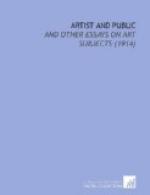Another accusation that used to be heard against our painters has been out-lived. We used to be told, with some truth, that we had learned to paint but had nothing to say with our painting, that we produced admirable studies but no pictures. The accusation never was true of our landscape-painting. Whatever may be the final estimation of the works of Inness and Wyant, there can be no doubt that they produced pictures—things conceived and worked out to give one definite and complete impression; things in which what was presented and what was eliminated were equally determined by a definite purpose; things in which accident and the immediate dominance of nature had little or no part. As for Winslow Homer, whether in landscape or figure painting, his work was unfailingly pictorial, whatever else it might be. He was a great and original designer, and every canvas of his was completely and definitely composed—a quality which at once removes from the category of mere sketches and studies even his slighter and more rapid productions. And our landscape-painters of to-day are equally painters of pictures. Some of them might be thought, by a modern taste, too conventionally painters of pictures—too much occupied with composition and tone and other pictorial qualities at the expense of freshness of observation—while our briskest and most original observers have, many of them, a power of design and a manner of casting even their freshest observations into pictorial form that is as admirable as it is remarkable.
No one could enter one of our exhibitions without feeling the definitely pictorial quality of American landscape-painting, but these exhibitions do less justice to the achievement of our figure-painters. The principal reason for this is that many of our most serious figure-painters have been so much occupied with mural decoration that their work seldom appears in the exhibitions at all, while the work that they have done is so scattered over our vast country that we rather forget its existence and, assuredly, have little realization of its amount. It is one of the defects of our exhibition system that work of this kind, while it is, of course, on permanent exhibition in the place for which it is painted, is hardly ever “exhibited,” in the ordinary sense, in the centres where it is produced. The regular visitor to the Paris salons might know almost all that has been done in France in the way of mural painting.




